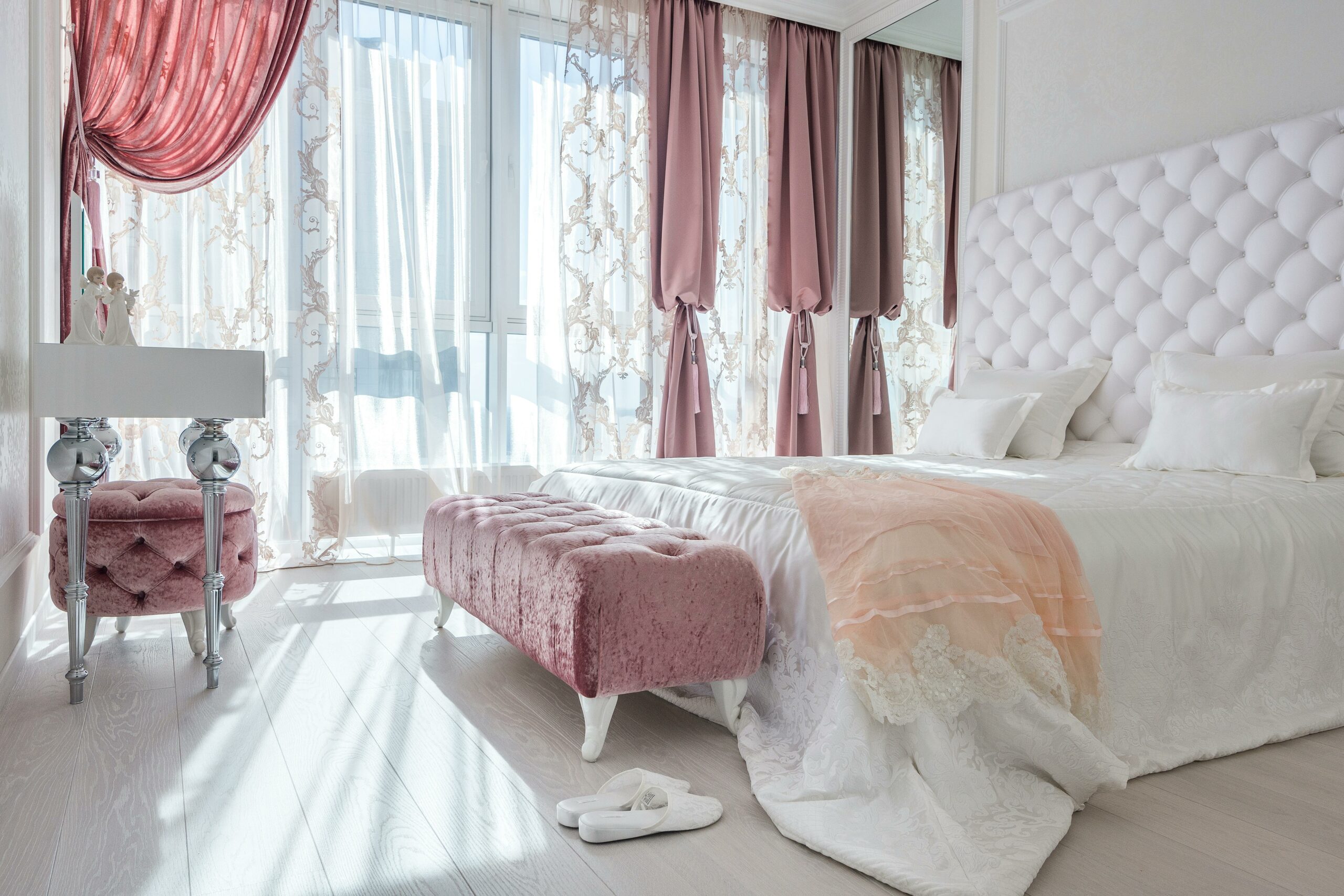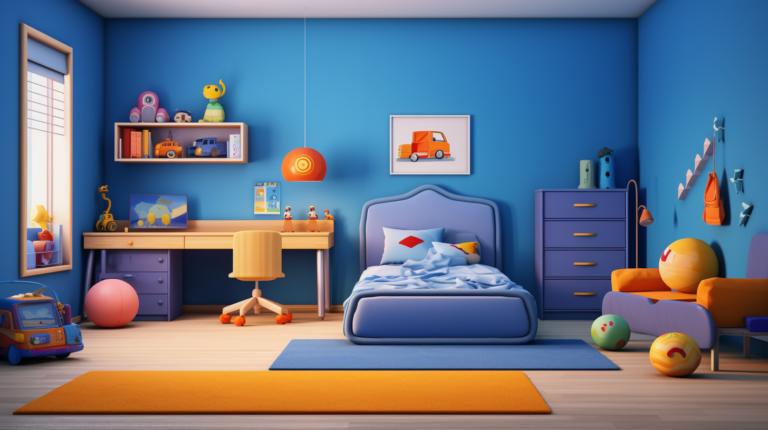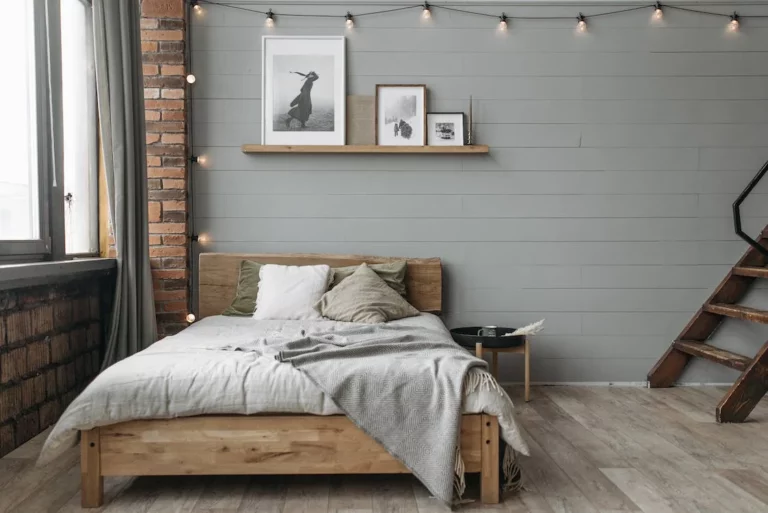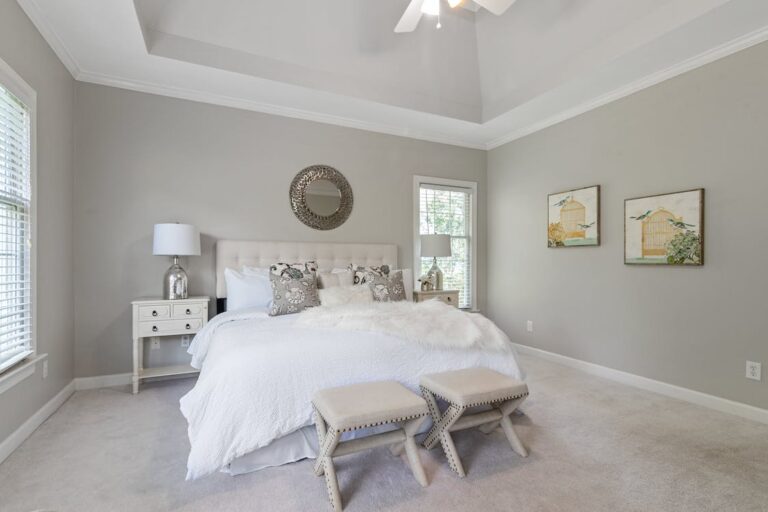Refreshing Bedroom Decor with Textured Elements
When it comes to creating a serene and inviting bedroom space, paying attention to the details is key. One often overlooked aspect of bedroom decor is the use of textures. Incorporating different textures into your bedroom design can add depth, intrigue, and a touch of luxury to the space. From cozy fabrics to textured wallpapers, there are countless ways to introduce these elements and transform your bedroom into a stylish and comfortable sanctuary. In this article, we will explore the role of textures in interior design, discuss various ways to incorporate them into your bedroom decor, provide tips on balancing textured elements, and address common mistakes to avoid. So let’s dive in and discover how to refresh your bedroom decor with textured elements!
Table of Contents
Role of Bedroom Decor Textures in Interior Design
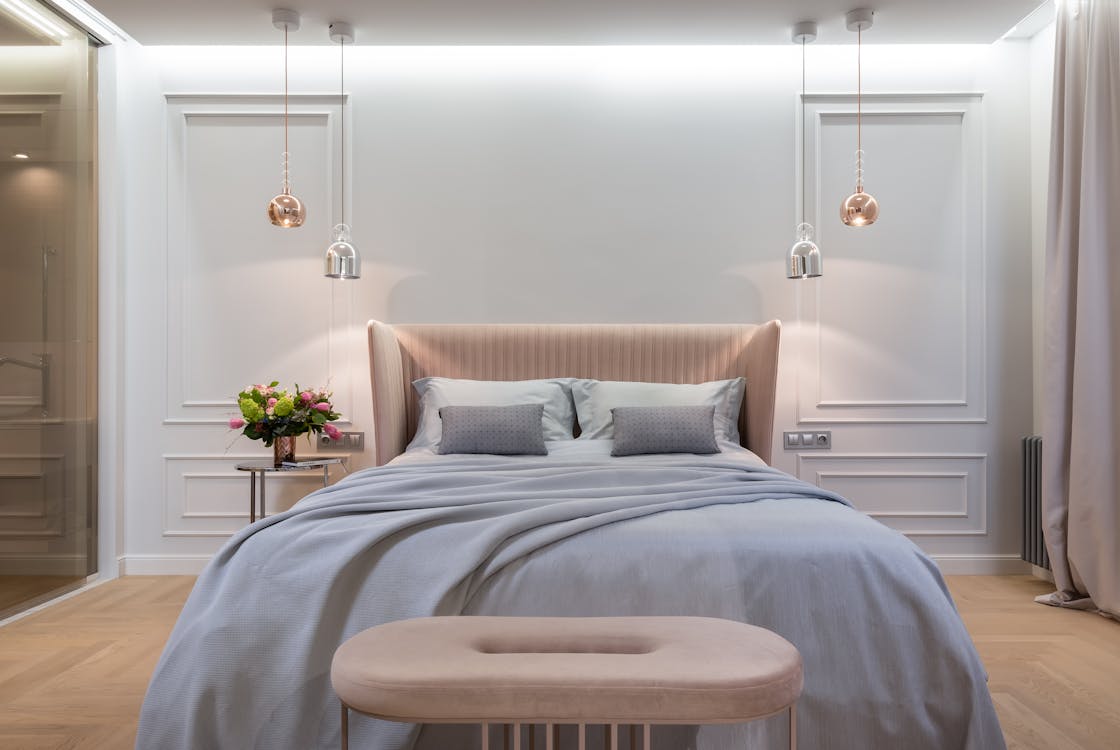
Textures play a crucial role in interior design, as they have the power to transform a space, evoke emotions, and create a harmonious atmosphere. When used effectively, textures can add depth, intrigue, and personality to any room. Whether it’s a rough-hewn stone fireplace, plush velvet upholstery, or a beautifully woven rug, each texture brings its own unique characteristics to a space.
Adding Depth and Intrigue
One of the main benefits of incorporating textures into interior design is that they add depth and visual interest to a room. By mixing different textures, you can create a visually dynamic space that engages the senses and invites exploration. Here are a few ways textures can add depth and intrigue to your interior design:
- Contrast: Contrasting textures, such as pairing smooth and rough surfaces, creates a visually striking effect. For example, combining a sleek leather sofa with a rustic wooden coffee table adds visual interest and balance.
- Layering: Layering textures provides a sense of dimension and richness to a room. By combining different fabrics, materials, and finishes, you can create a visually compelling space. For instance, layering a cozy faux fur rug over a hardwood floor adds warmth and tactile appeal.
- Textured Walls: Consider incorporating textured walls into your design scheme. Whether it’s through wallpaper, textured paint, or wall panels, textured walls can instantly elevate the look and feel of a room. They add depth and create a captivating backdrop for other design elements.
Creating a Cozy Atmosphere
Textures have a significant impact on how we perceive comfort and coziness in a space. They can make a room feel warm, inviting, and snug. Here’s how textures can help you create a cozy atmosphere:
- Soft Fabrics: Incorporate soft and tactile materials like velvet, chenille, or cashmere into your design. Plush cushions, cozy throws, and fluffy rugs not only add comfort but also create an inviting ambiance that encourages relaxation.
- Natural Elements: Bring in natural textures from materials like wood, stone, or fibers like jute or sisal. These organic elements create a connection to the outdoors, adding warmth and a sense of tranquility.
- Warm Colors: Combine textures with warm, earthy colors like deep browns, rich oranges, and soft creams to create a cozy and comforting atmosphere. These colors, combined with textured surfaces, can make a room feel intimate and welcoming.
Highlighting Architectural Features
Textures not only enhance the overall ambiance of a space but can also highlight architectural features and details. Here’s how you can use textures to accentuate the architectural elements in your interior design:
- Exposed Brick: If you have an exposed brick wall, embrace its rough texture and allow it to become a focal point in the room. Pair it with sleek and modern furniture to create a striking contrast.
- Wainscoting or Paneling: Use textured wainscoting or paneling to highlight walls and add depth to a room. This technique not only adds visual interest but also emphasizes the architecture and craftsmanship.
- Ceiling Treatments: Don’t forget about the ceiling! Incorporating textured materials, such as tin ceiling tiles or exposed beams, can draw the eye upward and make a design statement.
In conclusion, textures are an essential element of interior design. They have the power to add depth, create a cozy atmosphere, and highlight architectural features. By selecting and combining textures thoughtfully, you can transform any space into a visually captivating and inviting environment.
Incorporating Different Textures into Bedroom Decor
When it comes to designing a bedroom, one element that often gets overlooked is texture. Many people focus on color schemes or furniture choices but forget about the impact that different textures can have on the overall ambiance of the room. However, by incorporating various textures, you can create a visually appealing and inviting space that feels cozy and luxurious. In this article, we will explore different ways to incorporate textures into bedroom decor, from textured wallpapers to velvet drapes and upholstery, rugs and carpets, bed linen, and decorative throw pillows and blankets. Let’s dive in!
Textured Wallpapers
Textured wallpapers are a fantastic way to add depth and visual interest to your bedroom walls. With a wide range of options available, you can choose from embossed patterns, raised textures, or even faux finishes that mimic the look and feel of natural materials like brick or wood. Not only do these textured wallpapers add a tactile dimension to your room, but they also serve as a backdrop that complements other decorative elements. They can create a sense of warmth and coziness, making your bedroom a haven of relaxation.
Velvet Drapes and Upholstery
Velvet is a luxurious fabric that instantly elevates the elegance of any room. By incorporating velvet drapes or upholstery into your bedroom decor, you can add a touch of opulence and sophistication. The soft and plush texture of velvet creates a cozy and inviting atmosphere, perfect for unwinding after a long day. Plus, velvet comes in a variety of rich colors, allowing you to customize your bedroom to suit your personal style. Whether you opt for velvet curtains or a velvet headboard, this texture is sure to make a statement.
Rugs and Carpets
Rugs and carpets are not only functional but also provide an opportunity to introduce texture to your bedroom. From soft and fluffy shag rugs to tightly woven sisal carpets, there are endless options to choose from. By incorporating a rug or carpet in your bedroom, you can create a sense of warmth and comfort underfoot while adding a layer of visual interest. Consider the color and texture of the rug or carpet to complement the overall theme of your bedroom and create a harmonious space.
Bed Linen
Bed linen is often an underrated way to add texture to your bedroom decor. Opting for different types of fabric and weaves can make a significant difference in the overall look and feel of your bedding. Consider incorporating materials like crisp cotton, smooth silk, or cozy flannel to add texture and tactile interest to your bed. Additionally, explore different weaving patterns such as jacquard or herringbone for a visually appealing effect. By choosing bed linen that has different textures, you can enhance the tactile experience and create a visually interesting bed.
Decorative Throw Pillows and Blankets
One of the easiest and most versatile ways to incorporate texture into your bedroom decor is through decorative throw pillows and blankets. These small accents can make a big impact on the overall aesthetic of your room. Opt for pillows and blankets with different textures, such as knitted designs, faux fur, or embroidered patterns. Mixing and matching different textures can add depth and visual interest to your bed or seating area. Don’t be afraid to experiment with various textures and patterns to create a unique and inviting look.
Incorporating different textures into your bedroom decor is a surefire way to create a visually appealing and inviting space. From textured wallpapers to velvet drapes and upholstery, rugs and carpets, bed linen, and decorative throw pillows and blankets, there are endless possibilities to explore. By layering different textures, you can add depth and tactile interest to your room, making it a cozy and luxurious retreat. So why wait? Start experimenting with textures and transform your bedroom into a haven of style and comfort.
Balancing Textured Elements in Bedroom Decor
Have you ever walked into a beautifully styled bedroom and immediately felt a sense of warmth and coziness? Chances are, one of the key elements that contributed to that feeling is the thoughtful balance of textures in the room’s decor. When it comes to creating a visually interesting and inviting bedroom, texture plays a crucial role. In this article, we will explore some tips and tricks for effectively balancing textured elements in bedroom decor.
Colour Coordination
One of the first things to consider when balancing textures in your bedroom decor is color coordination. By selecting a color palette that complements your chosen textures, you can achieve a harmonious and cohesive look. Here are a few pointers to keep in mind:
- Stick to a cohesive color scheme: Choose a few key colors that work well together and incorporate them throughout your bedroom decor. This will create a sense of unity and prevent the textures from overwhelming the space.
- Mixing neutrals with pops of color: Neutrals, such as whites, grays, and beiges, are a great starting point for creating a balanced foundation. Consider adding pops of color through accent pieces or textiles to add interest and dimension to the space.
- Consider the mood: The colors you choose can also impact the mood of your bedroom. Soft, muted tones can create a calming and tranquil atmosphere, while vibrant hues can inject energy and personality into the space.
Mixing Different Textures
Once you have established a cohesive color scheme, it’s time to start mixing different textures in your bedroom decor. This is where the magic happens! By incorporating a variety of textures, you can create a visual feast for the eyes and add depth and tactile interest to your space. Here are a few ideas to get you started:
- Layering textiles: Experiment with different fabrics such as linen, velvet, and knit to create a visually appealing and cozy atmosphere. Drape a chunky knit blanket over your bed or layer a faux fur rug over a sisal carpet for added texture and warmth.
- Mixing materials: Combining different materials such as wood, metal, and glass can add a touch of sophistication and contrast to your bedroom. Consider incorporating a wooden headboard, a metal bedside table, or a glass lamp to create an interesting interplay of textures.
- Playing with patterns: Don’t forget about the power of patterns! Mixing different patterns, such as stripes, florals, or geometric prints, can add texture and visual interest to your bedroom decor. Just be sure to keep the scale and color palette in mind to maintain balance and harmony.
Maintaining a Focal Point
As you bring together different textures in your bedroom, it’s important to create a focal point that anchors the space and guides the eye. A focal point serves as a visual centerpiece and helps to balance all the textures in the room. Here are a couple of ways to achieve this:
- Statement furniture: Invest in a standout piece of furniture that will grab attention and serve as the focal point of your bedroom. This could be a beautiful upholstered bed frame, an intricately designed dresser, or a unique armchair.
- Accent wall: Another option is to create an accent wall using textured wallpaper, reclaimed wood panels, or a bold paint color. By highlighting one wall in your bedroom, you create a focal point that adds depth and visual interest to the overall space.
In conclusion, achieving a balanced and visually appealing bedroom decor is all about incorporating a variety of textures while maintaining a cohesive color scheme. By carefully coordinating colors, mixing different textures, and creating a focal point, you can create a harmonious and inviting atmosphere in your bedroom. So go ahead, get creative, and let the textures take center stage in your bedroom decor!
Rectifying Common Mistakes with Textured Decor
Decorating a space with textured elements can instantly elevate its visual appeal and add depth to the overall design. However, like any design choice, it’s essential to execute it correctly to achieve the desired effect. In this section, we will explore some common mistakes people make when incorporating textured decor and how to rectify them for a more cohesive and visually pleasing space.
Avoiding Overcrowding
One of the most prevalent mistakes when using textured decor is overcrowding. While it’s exciting to experiment with different textures, cramming too many elements together can make a space feel chaotic and overwhelming. To avoid this, consider the following:
- Edit and declutter: Begin by taking a step back and evaluating the space. Remove any unnecessary items or excessive textures that may contribute to the cluttered look.
- Create visual balance: To maintain a visually balanced composition, vary the distribution of textured elements throughout the room. Instead of clustering them in one area, spread them out to create a cohesive flow.
- Focus on focal points: Choose one or two areas in the space to highlight with textured decor. By identifying focal points, you can draw attention to specific areas and avoid overwhelming the entire room.
Making Use of Different Light Sources
Lighting plays a crucial role in accentuating the textures in a space. It can highlight the intricate details and create an inviting atmosphere. Yet, overlooking lighting when incorporating textured decor is a common oversight. Here’s how to correct it:
- Layer lighting: Combine different light sources to create depth and highlight the textures in the room. Use a mix of ambient, task, and accent lighting to showcase the various elements.
- Adjust light intensity: Experiment with dimmers or adjustable light fixtures to control the intensity of the lighting. This allows you to highlight specific textures and create different moods as desired.
- Consider natural light: Natural light can enhance the beauty of textured decor. Position furniture and objects near windows to take advantage of natural sunlight and its inherent contours and shadows.
Preventing Clash of Textures
Although incorporating different textures can add interest to a space, it’s crucial to avoid clashing textures that may create a discordant atmosphere. Here’s how to prevent texture clashes:
- Stick to a cohesive color palette: Use a consistent color scheme that complements the various textures. This will help tie the elements together and create a cohesive look.
- Consider scale and proportion: Balance the scale of different textures within the space. For example, if you have a large textured rug, pair it with smaller, less dominant textured accent pieces.
- Combine contrasting textures: Instead of combining similar textures that may clash, opt for contrasting ones to create visual interest. For example, pair a smooth, sleek surface with a more rough and tactile texture for balance.
Inability to Make a Statement
Sometimes, despite incorporating various textured elements, a space fails to make a statement. This can occur when textures are not strategically placed or lack a cohesive theme. To rectify this, try the following:
- Choose a focal point texture: Select one standout texture to be the focal point of the space. This could be a textured wall, a statement piece of furniture, or a textured accent wall.
- Establish a theme: Create a design concept or theme that revolves around a specific texture or a combination of textures. This will help guide your choices and ensure a cohesive and visually striking result.
- Layer and mix textures: Experiment with layering different textures to add depth and richness to the overall design. Combine soft and plush textures with more rugged or organic ones for a dynamic and visually appealing space.
By avoiding overcrowding, utilizing different light sources, preventing texture clashes, and focusing on creating a statement, you can rectify common mistakes with textured decor and transform your space into a visually stunning haven. Embrace the beauty of textures and let them bring new life to your interior design.
Importance of Personal Taste in Texture Selection
When it comes to selecting textures for our surroundings, personal taste plays a crucial role. The textures we choose can significantly impact the overall look and feel of a space, whether it’s our home, office, or any other environment we spend time in. Understanding the importance of personal taste in texture selection allows us to create spaces that not only look aesthetically pleasing but also resonate with our individual preferences and needs.
Here are a few reasons why personal taste should be a priority when it comes to selecting textures:
1. Reflecting Your Personality
The textures we surround ourselves with can be a reflection of our personality and individuality. Whether you prefer sleek and polished surfaces or more rustic and natural textures, your choice of textures can speak volumes about your style and preferences. By selecting textures that align with your personal taste, you can create a space that feels uniquely yours.
2. Creating Comfort and Coziness
Different textures evoke different sensations and feelings. Soft and plush textures can create a sense of comfort and coziness, while smooth and glossy surfaces can add a touch of elegance and sophistication. By considering your personal taste, you can choose textures that make you feel at ease and promote a sense of relaxation in your environment.
3. Enhancing Visual Interest
Textures have the power to add visual interest and depth to a space. By mixing textures that you find visually appealing, you can create a dynamic and layered environment that catches the eye. Personal taste allows you to select textures that you find visually stimulating, making your space more visually appealing and engaging.
4. Creating a Harmonious Space
When choosing textures, it’s important to consider how they work together to create a harmonious overall look. Personal taste helps you identify textures that complement each other and create a cohesive design scheme. By selecting textures that you personally find pleasing and balanced, you can ensure that your space feels harmonious and well put together.
5. Promoting Well-being
Textures have the ability to affect our emotions and well-being. For example, natural textures like wood or stone have a calming and grounding effect, while brighter and more vibrant textures can energize a space. By considering your personal taste and the emotional impact of different textures, you can create an environment that promotes a sense of well-being and suits your emotional needs.
In conclusion, personal taste plays a significant role in texture selection. By taking into account your preferences and needs, you can create spaces that reflect your personality, enhance comfort, promote visual interest, create harmony, and contribute to overall well-being. So, when it comes to selecting textures for your surroundings, trust your instincts and prioritize personal taste to create spaces that truly feel like home.
Also Read : Minimalist Bedroom in 2024 : Tranquil and Serene Haven
Conclusion
In conclusion, incorporating textured elements into bedroom decor can have a transformative effect on the overall ambiance and aesthetic appeal of the space. By adding depth, creating coziness, and highlighting architectural features, textures play a crucial role in interior design.
To achieve a refreshing and visually pleasing bedroom, consider incorporating different textures such as textured wallpapers, velvet drapes and upholstery, rugs and carpets, bed linen, and decorative throw pillows and blankets. Balancing these textured elements through color coordination, mixing different textures, and maintaining a focal point is essential for creating a harmonious and inviting space.
However, it’s important to avoid common mistakes such as overcrowding with too many textures, not making use of different light sources, preventing clash of textures, and failing to make a statement. By paying attention to these factors, you can ensure that your textured bedroom decor will be visually appealing and comfortable.
Remember, the importance of personal taste in texture selection cannot be overstated. Experiment with different textures and find what resonates with you and your style preferences.
So go ahead and elevate your bedroom decor with textured elements to create a space that is visually captivating and inviting. For more inspiring ideas and tips related to architecture, home and interior design, and decoration, visit Arkitecture Today.
Frequently Asked Questions
- What are some textured elements that can be used in bedroom decor?Some textured elements that can be used in bedroom decor are: 1. Textured wallpaper, 2. Knitted or woven blankets, 3. Faux fur or shaggy rugs, 4. Embossed or patterned throw pillows, and 5. Textured wall art.
- How do textured elements enhance the overall bedroom decor?Textured elements add depth, visual interest, and a cozy touch to the bedroom decor. They make the space feel more inviting and visually appealing. Textures also provide a tactile experience and can create a sense of comfort and luxury.
- How can I incorporate textured elements without overwhelming the bedroom decor?To incorporate textured elements without overwhelming the bedroom decor, opt for a cohesive color palette and choose textures that complement each other. Mix and match textures with different scales and patterns. Start with small accents and gradually introduce more textured elements if desired.
- Are there any textured elements that can help create a relaxing ambiance in the bedroom?Yes, certain textured elements can help create a relaxing ambiance in the bedroom. Examples include soft and plush textures like velvet or silk, natural and organic textures like woven baskets or bamboo accessories, and calming colors paired with textured materials.
- Can I use textured elements in a minimalist bedroom decor?Yes, textured elements can be used in a minimalist bedroom decor. In a minimalist setting, focus on using fewer, but well-chosen textured elements. Select organic textures and keep the color palette simple and monochromatic to maintain the clean and uncluttered feel of the minimalist style.

